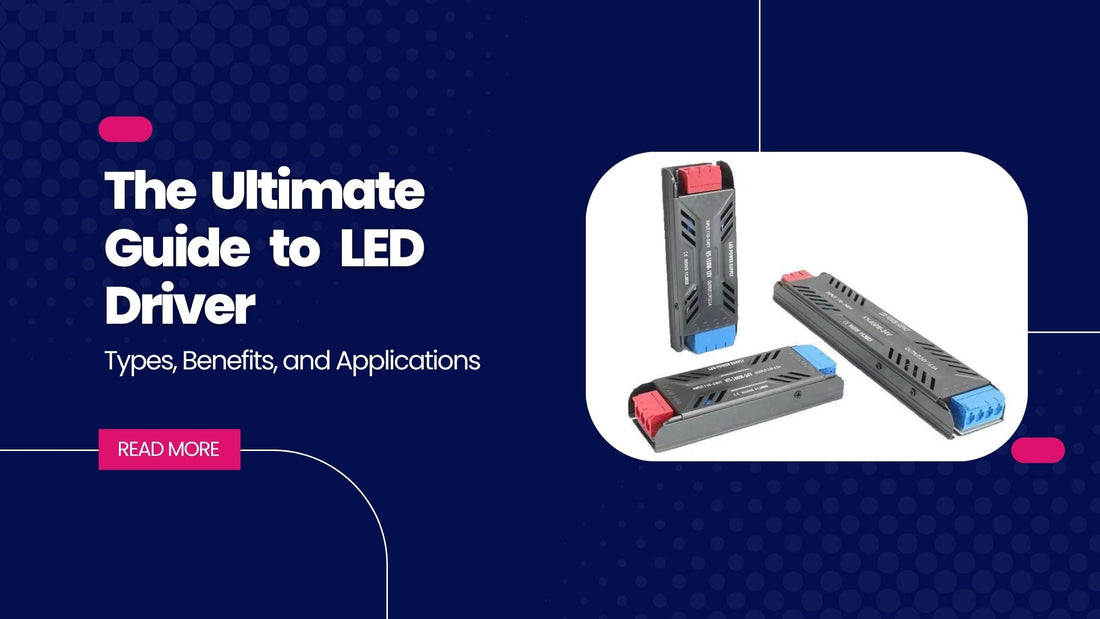
The Ultimate Guide to LED Driver: Types, Benefits, and Applications
Share
Introduction
LED lighting has revolutionized the way we illuminate our spaces, offering energy efficiency, longevity, and versatility. However, the unsung hero behind the seamless operation of LEDs is the LED driver. This guide delves deep into the world of LED drivers, explaining their types, importance, benefits, and applications. Whether you're a homeowner, a business owner, or an industrial lighting specialist, understanding LED drivers is crucial for optimizing your lighting solutions.
What Is an LED Driver?

An LED driver is an electrical device that regulates the power supplied to an LED or a string of LEDs. Unlike traditional incandescent bulbs, which operate directly from the mains voltage, LEDs require a constant current or voltage to function efficiently. The LED driver acts as a power supply, converting the incoming AC voltage to the appropriate DC voltage and current required by the LED. This regulation prevents common issues like flickering, overheating, or premature failure, ensuring the LED operates at its optimal performance.
LED drivers are designed to handle the unique electrical characteristics of LEDs. For instance, LEDs have a non-linear voltage-current relationship, meaning a small change in voltage can cause a significant change in current. Without a driver, this could lead to thermal runaway, where the LED draws excessive current, overheats, and fails. The driver mitigates this risk by maintaining a stable power supply. In many setups, a combined led driver power supply is used to simplify installation and improve efficiency.
Learn more about LED functionality and energy efficiency from Energy.gov on LED Lighting
Why Are LED Drivers Important?
LEDs are highly sensitive to fluctuations in power, making the role of an LED driver indispensable. Here’s why:
- Overvoltage: Excessive power can cause the LED to draw more current than it can handle, leading to burnout. The driver limits the current to a safe level.
- Undervoltage: Insufficient power can dim the LED or cause flickering, affecting performance. The driver ensures consistent power delivery.
- Temperature variations: Poor regulation can lead to overheating, which reduces the LED's lifespan. Drivers often include thermal protection to prevent this.
By maintaining a stable power supply, LED drivers enhance performance, efficiency, and durability, making them a critical component in any LED lighting system.
Types of LED Drivers
Constant Current LED Drivers
These drivers deliver a fixed current (e.g., 350mA, 700mA) while allowing the voltage to vary within a specified range. They are ideal for high-power LEDs, such as those used in streetlights, industrial lighting, or high-bay fixtures. Constant current drivers ensure that the LED receives a consistent current, regardless of voltage fluctuations, which is essential for maintaining brightness and longevity.
Constant Voltage LED Drivers
These provide a fixed voltage (e.g., 12V, 24V) and are commonly used for LED strips, signage, and other applications where multiple LEDs are connected in parallel. Constant voltage drivers are simpler in design and are often used in low-power applications. They require the LED circuit to include resistors or other current-limiting mechanisms to prevent overcurrent.

Dimmable LED Drivers
These drivers allow for brightness adjustment and are compatible with dimmer switches. They are popular in residential and commercial settings for creating mood lighting or energy-saving scenarios. Dimmable drivers can use various dimming methods, such as PWM (Pulse Width Modulation) or analog dimming, to adjust the light output smoothly. Whether it’s a constant voltage or constant current system, choosing the right led driver and power supply combination is essential for achieving optimal dimming performance.
Benefits of Using LED Drivers
- Energy Efficiency: LED drivers optimize power usage, reducing electricity costs by ensuring the LED operates at its most efficient point.
- Longevity: By protecting LEDs from power surges and fluctuations, drivers extend the lifespan of the lighting system.
- Versatility: LED drivers support a wide range of applications, from small home lighting setups to large-scale industrial installations.
Applications of LED Drivers
LED drivers are used in diverse settings, including:
- Residential lighting: Bulbs, downlights, and under-cabinet lighting.
- Commercial spaces: Offices, retail stores, and hospitality venues.
- Industrial environments: Warehouses, factories, and high-bay lighting.
- Outdoor lighting: Streetlights, billboards, and landscape lighting.
Conclusion
An LED driver is the backbone of any LED lighting system, ensuring reliable and efficient operation. Whether for residential, commercial, or industrial use, choosing the right driver is critical for performance and longevity. Ready to upgrade your lighting? Explore our range of LED drivers today!
FAQs About LED Drivers
1. Can I use any LED driver for my LED lights?
No, you must match the driver’s specifications (current, voltage, wattage) with your LED’s requirements. Using an incompatible driver can damage the LED or reduce its performance.
2. How do I know if my LED driver is failing?
Signs include flickering, dimming, or complete failure of the LED. In some cases, the driver may emit a buzzing sound or overheat.
3. Are dimmable LED drivers more expensive?
Yes, they typically cost more due to the advanced circuitry required for dimming functionality.
4. Can I replace an LED driver myself?
Yes, but ensure you follow safety guidelines and use a compatible driver. Always disconnect power before attempting any replacements.
5. Do all LED lights need a driver?
Most do, but some low-voltage LEDs, such as those in battery-operated devices, may have built-in drivers.
6. Why led driver fails?
LED drivers fail due to overheating, voltage spikes, overcurrent, poor quality components, or age.
7. Which driver for led strip?
Use a constant voltage LED driver for LED strips, matching the strip’s voltage and total current.
8. What is buck led driver?
A buck LED driver steps down voltage while regulating current to safely power LEDs efficiently.
9. What is linear led driver?
A linear LED driver regulates current using a series resistor or linear control, offering simple, quiet operation but lower efficiency.
10. What is led driver module?
An LED driver module is a pre-assembled unit that regulates voltage and current to power LEDs safely.
Frequently Linked Pages:
1. LED Driver Power Supply - Everything You Need to Know About LED Driver Power Supply
2. LED Driver and Power Supply - Complete Guide to LED Driver and Power Supply for Efficient LED Lighting
3. Power Supply 12V - Power Supply 12V: Difference Between Halogen Transformers and LED Driver Power Supply
